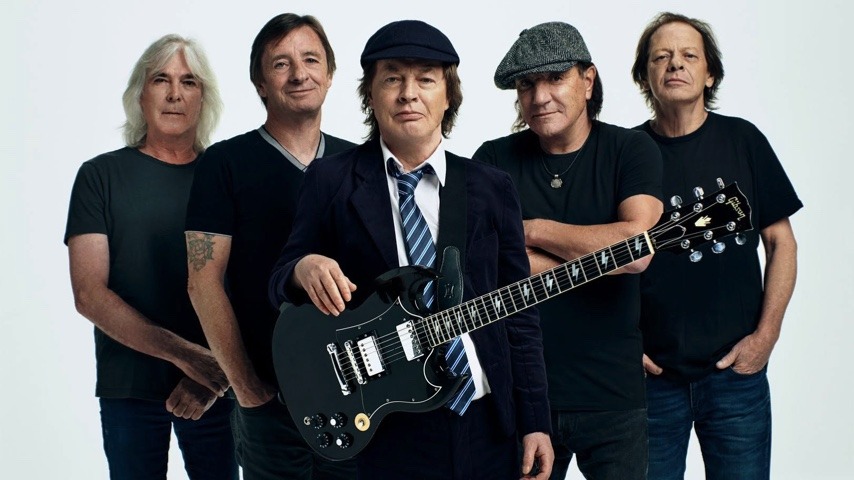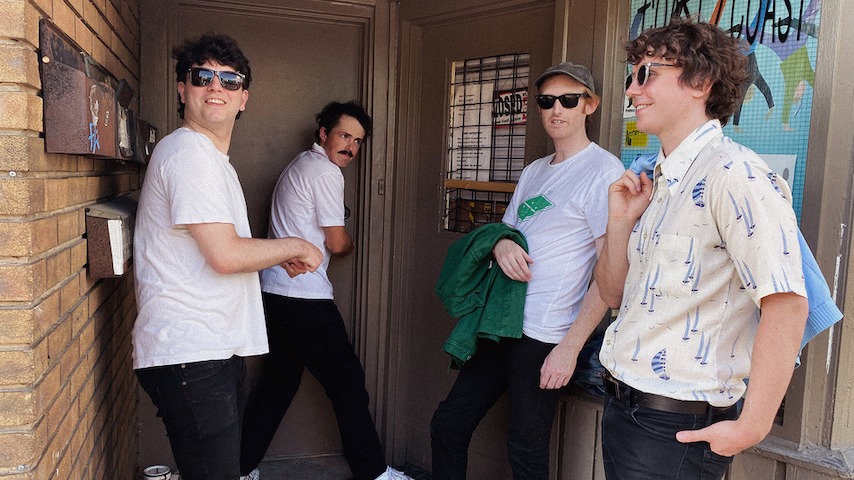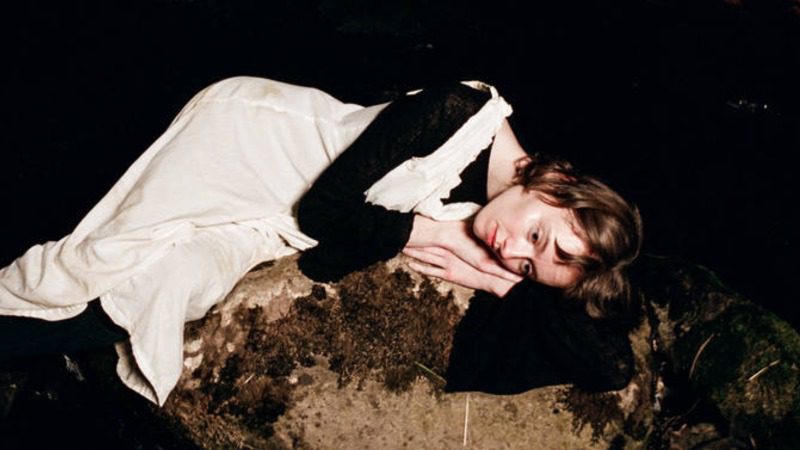It might not have been the coronovirus-killing cure that humanity was seeking last year. But when Aussie quintet AC/DC released its 17th adrenaline-riffed album Power Up on November 13—in the darkest heart of the pandemic—it certainly felt like just what the doctor ordered: If not a perfect panacea, at the very least a booster-shot reminder of the invigorating tonic that these Rock and Roll Hall of Famers have been providing since 1973. The band’s never-say-die motto resonated, as well, rising from the metaphorical dead twice now—first after the 1980 death of charismatic frontman Bon Scott, when he and his rhythm guitarist brother Malcolm rebounded with an equally-distinctive new singer, Brian Johnson, and the now-definitive catalog classic “Back in Black.”
And it looked like curtains again during the yearlong tour supporting 2014’s “Rock or Bust.” Drummer Phil Rudd bowed out to deal with legal issues; bassist Cliff Williams decided to retire at the end of the taxing juggernaut; frontman Brian Johnson, having been warned by physicians to stop performing or risk losing his hearing, ceded its 10 final dates to replacement vocalist—and huge AC/DC fan—Axl Rose. For founding lead guitarist Angus Young, the process had been difficult enough recording the disc and then touring without his rhythm guitarist brother Malcolm Young on board, who had also retired after having been diagnosed with early onset dementia—replaced by the siblings’ nephew, Stevie Young—he died in 2017, leaving the group’s future once again in serious doubt.
But AC/DC managed to defy the odds once again. Under the rock-solid production of their usual producer Brendan O’Brien, Rudd, Williams, and a newly-revitalized Johnson—who had been rehabilitated by an in-ear technical specialist—reassembled with the two Youngs in a Vancouver studio owned by Bryan Adams late in 2018 to cut their Power Up comeback, using 12 vintage Malcolm co-writes Angus unearthed from his Sydney vaults.
And while some of the quintet’s efforts—notably “Back in Black,” “Highway to Hell,” and “Let There Be Rock” are in-your-face apparent—this one is a grower, a serpentine-riffed python that sneaks up and coils more tightly around you with each successive listen, from slinky stompers like “Rejection” and “Wild Reputation” to the bluesy “Kick You When You’re Down,” the arena-huge “Mists of Time,” and the one nod to sharp-hooked, lyrical-double-entendre traditionalism, “Shot in the Dark,” with its irresistible chant-along chorus. “A shot in the dark beats a walk in the park,” the banshee-throated Johnson yowls, and it could be about selecting a smoky bordello for your chosen sexual tryst instead of rolling the dice on a streetwalker, or it could concern the perils of a nocturnal nature walk—as always, with a sly truant wink befitting of Angus Young’s ageless bratty-schoolboy uniform—AC/DC leaves it to the listener to decide. But—even though he’s reached official retirement age, 65—the axeman feels like he’s just getting started, and he points out that “Back in Black” itself wasn’t an overnight sensation. It took a full year of world touring until it finally found its audience. “Sometimes you make something, and at first, some people might go, ‘Yeah—I get it,’” he says, phoning last week from his home in Sydney. “Or people who follow you go, ‘Yeah—that’s AC/DC. I get what they’re doing.’ And then other times, it’s songs that just creep up on you. So we’ve been very lucky throughout our career that with whatever we’ve done, we’ve been able to strike chords with people.”
Paste: If you pare it down, AC/DC has always basically been the blues, right?
Angus Young: Yeah. And if you’ll notice, in most rock ’n’ roll music, there is a basis of that blues element. And it’s the same for us. When I grew up, I listened to a lot of blues music, and my brother Malcolm was the same. Blues is just a part of your influence. And my sister [Margaret], even when I was very young, took me to see music. And she would get records for us, and especially a lot of old blues. She would get a whole collection of them and play them, and she took Malcolm and myself when we were younger to see a big open-air show with Louis Armstrong, and that always stuck in my mind. Maybe at the time we were so young that we didn’t realize it, but then later on you realize that here was this man with this big history of music, so it was always good. There was always in our household records like that being played, like Armstrong’s early ones. And other brothers would be playing Presley and Buddy Holly, and another brother would be playing a bit of Bob Dylan. There was always a lot of music and styles coming to Malcolm and myself.
Paste: Your sister helped you choose your schoolboy short pants stage outfit, too, right?
Young: Yes. And the school suit is what got me noticed. And it was really my sister’s suggestion. And also my brother George—he said, “That’d be really cool, Angus! They’ll see you as this little kid up there, and you’ll really attract attention—it’ll be a great gimmick!” And then Malcolm said, “Yeah, you’ve got to do that.” And I was more or less locked into it then, like, “Okay, if this is what I’m gonna do, then I’m gonna do it!”
Paste: And then came the traditional wait-for-it, wait-for-it audience mooning.
Young: Heh heh. Well, that really just came out of when we’d be playing somewhere and it was getting really rough and rowdy with people fighting and stuff, Malcolm used to say, “It’s getting out of hand—do something to get their attention!” So I’d just moon ’em.
Paste: Do you have your suits made by a certain designer now? Or Brian his signature caps?
Young: My school suit? No, I just get them made up as I need them, and usually every tour I get maybe a dozen or so, in different colors. But when I was younger, the first school suit I wore actually was my school suit that my sister adapted, my old school blazer. She got it and adapted it, because here in Australia, that’s what you wore—everyone went to school, and every day they had all the kids in uniforms and I don’t know why. I think they wanted everyone the same, not looking like rich and poor. They thought a uniform would keep everyone on the same level—that was what you got told, anyway.
Paste: What kind of student were you?
Young: Well, as a student, I would probably say… I was very invisible. If I could avoid school, I did, and I was pretty good at not showing up. In fact, I think the principal once had said to me that he didn’t really feel that I should be at the school, and I said, “Well, that’s one thing we can agree on!” And when one of your parents would show up at school, suddenly the headmaster was all very nice to you, and I’d go, “Well, that’s not what you said before!”
Paste: When you think about it, what you’ve done is pretty amazing. How many bands—outside of maybe Genesis—have lost a charismatic lead singer and then come back twice as strong?
Young: Yeah. And that was probably the hardest moment for us as a band at that time—whether we continue or stop. Because, you know, Bon Scott, when he died—with his own unique style and character and how he performed—we knew we were not gonna find somebody as unique who’d lived that character. So the choice for us really was, we had to find somebody who we felt had their own different character, and we were lucky that Brian had that. He had his own unique character.
Paste: And you’d toured with his old outfit Geordie already.
Young: That’s right. And Bon had been in a band and they had done dates, playing around together, especially in Britain. So he had done dates with the Geordie band. And Bon had always said about Brian that he had that good Little Richard thing, because Little Richard had that great rock ’n’ roll tone to his voice. And Bon said that when he heard Brian singing for the first time that he had that same feeling, he had that kind of Little Richard feeling about him. But I always took my cues from Malcolm, because Malcolm got us through, especially in the Bon era. [After Scott’s death in February of 1980] Malcolm said, “We’ll just continue doing what we do. We’ll just carry on and not even think about what we’re going to do.” So it was really after we had been to Bon’s funeral and talked with his parents—and especially Bon’s father had been the one who had said to us, “Bon loved working with you two guys—he would have really wanted you to go on.” And that was good for us, because it felt like we had his blessing. So that got us through that time, and it’s pretty much the same now. Like with Malcolm—even though he was very ill over a few years, he still was very clear and was always one for saying, “You’ve gotta keep going at it. You’ve gotta keep playing.” He was a very strong personality, Malcolm. And when he played guitar, he was totally unique in the way that he played. He played that hard rhythm, and it was his own style of playing. And as my older brother used to say, “It’s not what Malcolm plays—it’s what he leaves out.”
Paste: I was one of the first writers to talk to Axl Rose for Appetite, and we ended up recalling both being at Market Square Arena in Indianapolis for the “Back in Black” tour, and being dumbfounded by that incredible opening with Brian hitting the giant gong and you suddenly appeared high up, stage right, playing the opening lead to “Hells Bells.” When he stepped in, he must have known all the songs by heart.
Young: The first time I met Axl was in ’88, I think, at one of our shows. And he came back and was talking about some of the early things and what we had done. And later on, of course, when he came and helped us out, helped us finish off those dates and what we were doing, he was such a fan of us—especially a lot of the Bon songs—and he had stories for them all. He had better stories than what I had!
Paste: That gong was unforgettable. Just like the cannon on the following “For Those About to Rock We Salute You” tour.
Young: Well, the title comes from ancient Roman times, when the gladiators would go in and they’d be fighting in the arena. And before they went into battle, they would say, “For those about to die, we salute you.” And funnily enough, the first time I heard the phrase was, it was really Bon who had the book, and he was commenting on it. He’d read a story by that writer Robert Graves, and he used that title “For those about to die,” so that stuck with me, that quote, and the whole idea of that. And later, when we were putting the song together, we were at a rehearsal place in Paris, and while we were putting it together, there was a guy in the background, a night watchman, and he had a TV on, and I could hear cannons going off on the TV, and that kind of inspired me. And it just seemed so right. And I said, “What if we could get these cannons going off in sync? In sync to the music?” So that’s how that came into it.
Paste: This is probably urban mythology. But every once in a while you meet someone whose sister knew someone who was with someone at some music industry party, where somebody actually played a top-secret recording of Bon Scott singing some Back in Black songs before he died.
Young: Yeah, But no. There’s never been one. Bon never really got the chance. At the time, me and Malcolm were writing songs, which became the songs for Back in Black. We were in London in a rehearsal room, and Bon had come down, too. And what used to happen was, me and Malcolm would get together and get a drum kit, and Malcolm would get behind the drums sometimes, and I’d get on the guitar and just tap out a riff. Or other times, Malcolm would get on the guitar and he’d get me to just knock out a simple beat on the drums. Anyhow, we were working away, and it was on an intro which was actually what became the intro for “Hells Bells.” So Bon showed up, and Malcolm said, “Oh, great, Bon! You can get behind the kit!” Because originally, Bon started as a drummer. So Bon got behind the drum kit so we could try and work out this intro, how we wanted to do it. So we sorted that out how we wanted, and the other one was “Have a Drink on Me,” a riff Malcolm was playing around with. So we worked out the intro on that and how the song was gonna go. So he had Bon tapped to do a demo for that. So that was it, really. If you were looking up what Bon had done, it was really just to help us with those demos on the drums. And he even said to us, as we were knocking off in the night time, “Look, we’ll hook up next week.” He’d been working on some lyrics, and said, “We’ll hook up next week and maybe the three of us can just start going through stuff.” But unfortunately, he passed before that. And it’s kind of strange, in a way, when I think back, because when Bon first joined us as a band, that was the first thing he wanted to do—he took me and Malcolm and said, “Come on!” And we went to a friend’s place who had a studio, and when we got there, Bon got behind the drum kit and said, “Alright, come on you guys! Start playing!” And Malcolm said, “Look, Bon—we’ve got a real good drummer. We don’t need another drummer. What we need is a really good rock ’n’ roll singer!” But with Bon, what you saw was what you got. He had his own approach to this, and he lived that character. I mean, sometimes you’d be doing a gig somewhere, and he’d show up with some people, and then he’d be gone for a few days. And he’d have been out with some guys drinking moonshine up in the hills. He’d just met them, but they were all like his long-lost friends, ya know?
Paste: Where are some of the weirdest places you’ve heard your music playing?
Young: I think probably up there in the Himalayas, up there in Nepal. There were people there who loved us, and some people even told me that they have a cover band, that covers a lot of what we do, way up in the Himalayas.
Paste: And countless AC/DC tribute bands everywhere, including all-female versions like AC/DShe.
Young: Yeah. There’s a few of them. I remember because there was a man who won a guitar competition, and he brought them in, an all-girl band called Hell’s Belles. That was out in Seattle, I believe.
Paste: What is the scariest show you ever squeaked through?
Young: The scariest show? Hmm. There have been a lot of things over the years, so it’d be hard to say. But I remember in Seattle once, when somebody fired a rocket launcher into the dome, the roof of where we were playing—I think it was the Tacoma Dome. But the roof caught on fire, and I could see smoke, smoke all around me, but I didn’t know—I just thought, “Oh—have we got the smoke machine going?” Then I was walking around, and I couldn’t even see the band. And then I realized that the band wasn’t onstage—I was the only one standing there! And all of a sudden, I ran into people from the crew, who said, “We’ve gotta get you moving! There’s a fire!” So that was a little bit hairy. But they managed to get the fire out, and then we got back onstage and finished the show. And then you get the odd thing that might happen in different places, like, one time I was in the audience, playing away in the crowd, and there were a lot of people—too many people—because the whole grandstand came forward. So that was a bit scary. It was just me and one of our guitar guys, but there were so many people that it was a bit of a struggle to get the two of us out of that situation, and also make sure that the crowd wasn’t crushing each other.
Paste: I have to say, one of my favorite questions I’ve started throwing in to interviews over the past few years is, “Where were you when you first heard Back in Black?” And you’re so universal, almost everybody has an incredible story.
Young: Yeah? Well, I know where I was! I was in the Bahamas, recording it!




